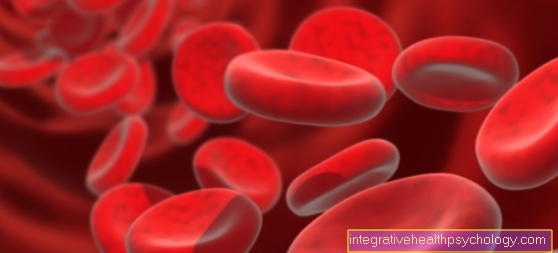Slimy bowel movements
Introduction - what is a slimy bowel movement?
Slimy stool is characterized primarily by its slimy deposits. In principle, the stool can be either solid or liquid. In addition, the stool can take on different colors, which may give an indication of the cause of the slimy stool.
In most cases, the stool itself is not slimy, but rather slimy additions or deposits during stool. This mucus can consist of various substances such as individual (mostly undigested) Consist of food components or digestive juices and saliva.
Depending on the color and consistency of the mucus and the stool, conclusions can be drawn about various causes.

Causes of slimy bowel movements
There are many causes of slimy stool. The most common causes vary greatly depending on the age of the person concerned.
In babies and toddlers, slimy stool usually has very harmless causes. Typically, at a time when the child is salivating a lot, some of the saliva enters the digestive tract. If the amount is so large that it cannot be completely absorbed in the intestine, the saliva will be noticed as light-colored mucus or often similar in color to the stool.
In the elderly, various digestive tract and metabolic disorders can cause inadequate processing of food in the intestine to cause slimy stool. For example, if there are diseases of the pancreas (pancreas) or the gallbladder, not enough digestive enzymes are added to the food pulp. This leads to incomplete digestion and the resulting slimy consistency.Food intolerances can also cause slimy stool via this mechanism.
If the composition of the normal intestinal bacteria is disturbed by antibiotics or gastrointestinal infections, the stool can also become slimy. Only in rare cases is a tumor (benign or malignant) of the digestive tract is responsible for the development of slimy stool. In addition, chronic inflammatory bowel diseases such as Crohn's disease or ulcerative colitis can trigger the symptoms.
Use of antibiotics for slimy stool
Antibiotics are drugs that are used against different types of bacteria. However, they not only work against the pathogens they are supposed to fight. Instead, the natural bacterial colonization of the intestine is also influenced by the antibiotics. This upsets the natural balance of the intestinal bacteria.
Since the bacteria in the intestine play a major role in the decomposition of the individual food components and thus in digestion, antibiotic therapy can make digestion significantly more difficult. Antibiotics, for example, can cause slimy bowel movements. In addition, antibiotic treatment often makes the stool thinner and it can also change its color temporarily.
Would you like to know more about the unwanted accompanying symptoms of antibiotic therapy? You can read more about this in our next article: Side effects of antibiotics
Diagnosis of slimy stool
The diagnosis of the symptom of slimy stool is initially based on a detailed anamnesis. The doctor asks about possible causes of the slimy stool and learns the duration and, if necessary, other accompanying symptoms.
This is followed by a physical examination during which the stomach in particular is listened to and palpated. Depending on the suspected cause of the slimy stool, other diagnostic means such as a blood sample or imaging (for example by means of ultrasound). In addition, the stool can be examined for pathogens.
In rare cases, an endoscopy of the gastrointestinal tract may be necessary. A camera on a flexible rod / tube is inserted into the intestinal sections to be examined via the mouth or anus, so that the digestive tract can be viewed from the inside. During the examination, biopsies (small tissue samples) for further investigation.
You may also be interested in the next topic: Course of a colonoscopy
I can tell from these symptoms that my slimy stool is abnormal
Whether mucus in the stool is a normal or a pathological deviation of the stool can usually best be differentiated by its color.
A light or colorless phlegm is in most cases harmless and often due to changes in diet or fluctuations in normal nutrition. Likewise, colored slime colored by certain recently ingested foods is not a cause for concern (green slime after spinach / lettuce, orange / red slime after carrots and peppers, etc..).
In contrast, yellowish mucus often indicates infectious diseases (the yellow color is caused by pus) or digestive enzyme disorders.
Red mucus or dark brown / black mucus is in most cases due to blood in the stool. This can only be caused by bleeding in the digestive tract and should therefore be investigated further.
If, in addition to the slimy stool, other symptoms such as abdominal pain, nausea, vomiting or a sharp change in the consistency of the stool (Constipation / diarrhea) occur, regardless of the color of the mucus, a pathological cause should be considered.
Slimy stool with blood
Slimy stool with blood is an indication of lesions (Injuries) in the gastrointestinal tract. A distinction is made between different states of the admixed blood.
Is it a light red (and thus fresh) Blood, the posterior sections of the intestine are usually injured, as the blood only enters the stool shortly before the anus. Has the blood already clotted - dark brown - the source of bleeding is in the higher intestinal tract.
Black blood mostly comes from the stomach, as the blood can only take on a black color due to the particularly strong stomach acid.
The digestion is disturbed by the damage to the intestinal mucosa, which makes the stool additionally slimy.
Are you interested in this topic? You can read more about this in our next article: Blood in the stool - what are the causes?
Slimy stool with diarrhea
Diarrhea is characterized by the fact that the stool becomes softer to fluid. In addition, the stool frequency increases to at least 3 bowel movements per day. If there are also slimy deposits in the stool, one should first think of an infectious disease of the digestive tract.
Due to the inflammation in the gastrointestinal area, digestion cannot take place as usual. This leads to the slimy additions in the stool. In addition, the inflammation means that the intestine does not absorb as much fluid from the stool as it normally does, which leads to diarrhea. This condition can basically be triggered by pathogens, chronic inflammation, wrong food or medication.
Read more interesting information on this topic at: Slimy diarrhea
You might also be interested in our next article: Causes of diarrhea
Treatment of slimy stool
In many cases, slimy stool does not need to be treated in the traditional sense. Especially when certain foods or drugs are responsible for the mucus in the stool, it is sufficient to omit these substances and no longer ingest them.
If, on the other hand, pathogens are responsible for the slimy stool, treatment is usually no more than symptomatic therapy with sufficient fluids and a slow diet after the infection. If necessary, the pathogens can be treated with medication.
More severe conditions such as inflammatory bowel disease or digestive disorders (Liver, gallbladder, pancreas) require a much more detailed therapy. For example, a blockage of the biliary or pancreatic ducts often requires surgical treatment. A drug substitution (EncoreDigestive enzymes can help with digestive problems.
In the case of chronic inflammation of the intestine, therapy with anti-inflammatory drugs may have to be carried out; in more pronounced cases, active ingredients are also used that reduce the strong reaction of the immune system.
If a tumor is responsible for the slimy stool, it is usually removed surgically, and special oncological therapy follows if necessary.
The following topic may also be helpful to you: Immunosuppressants
Duration vs. Forecast of slimy stool
The duration of the slimy stool can range from a few days to years of recurring complaints and depends heavily on the cause. Short-term illnesses or problems such as food changes, drug-induced slimy stool and infectious diseases usually subside after a little more than a week.
Chronic diseases of the digestive organs as well as inflammatory bowel diseases can cause recurrent mucous bowel movements and often have to be treated for life. Food intolerances also usually last a lifetime. However, the symptoms can go away completely by avoiding the triggering foods.
Recommendations from the editorial team
Further general information may also be of interest to you:
- bowel movement
- Colors of bowel movements
- Blood in the stool with diarrhea
- Yellow bowel movements
- Digestive problems























.jpg)





